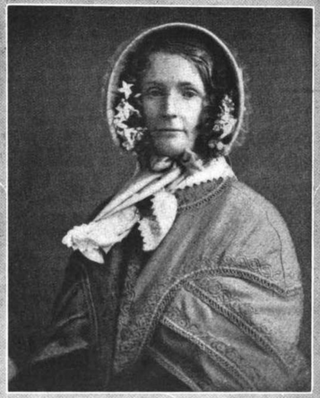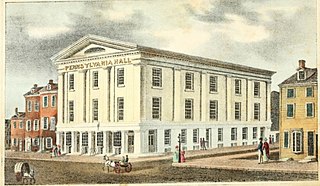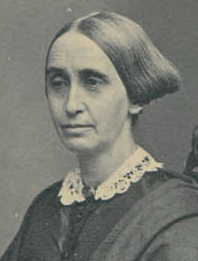
William Lloyd Garrison was an American abolitionist, journalist, and social reformer. He is best known for his widely read anti-slavery newspaper The Liberator, which Garrison founded in 1831 and published in Boston until slavery in the United States was abolished by the Thirteenth Amendment in 1865.

The American Anti-Slavery Society was an abolitionist society founded by William Lloyd Garrison and Arthur Tappan. Frederick Douglass, an escaped slave, had become a prominent abolitionist and was a key leader of this society, who often spoke at its meetings. William Wells Brown, also a freedman, also often spoke at meetings. By 1838, the society had 1,350 local chapters with around 250,000 members.

Lydia Maria Child was an American abolitionist, women's rights activist, Native American rights activist, novelist, journalist, and opponent of American expansionism. Her journals, both fiction and domestic manuals, reached wide audiences from the 1820s through the 1850s. At times she shocked her audience as she tried to take on issues of both male dominance and white supremacy in some of her stories.

Maria Weston Chapman was an American abolitionist. She was elected to the executive committee of the American Anti-Slavery Society in 1839 and from 1839 until 1842, she served as editor of the anti-slavery journal The Non-Resistant.

The Liberator (1831–1865) was a weekly abolitionist newspaper, printed and published in Boston by William Lloyd Garrison and, through 1839, by Isaac Knapp. Religious rather than political, it appealed to the moral conscience of its readers, urging them to demand immediate freeing of the slaves ("immediatism"). It also promoted women's rights, an issue that split the American abolitionist movement. Despite its modest circulation of 3,000, it had prominent and influential readers, including all the abolitionist leaders, among them Frederick Douglass, Beriah Green, Arthur and Lewis Tappan, and Alfred Niger. It frequently printed or reprinted letters, reports, sermons, and news stories relating to American slavery, becoming a sort of community bulletin board for the new abolitionist movement that Garrison helped foster.
The first Anti-Slavery Convention of American Women was held in New York City on May 9–12, 1837 to discuss the American abolition movement. This gathering represented the first time that women from such a broad geographic area met with the common purpose of promoting the anti-slavery cause among women, and it also was likely the first major convention where women discussed women's rights. Some prominent women went on to be vocal members of the Women's Suffrage Movement, including Lucretia Mott, the Grimké sisters, and Lydia Maria Child. After the first convention in 1837, there were also conventions in 1838 and 1839

Pennsylvania Hall, "one of the most commodious and splendid buildings in the city," was an abolitionist venue in Philadelphia, Pennsylvania, built in 1837–38. It was a "Temple of Free Discussion", where antislavery, women's rights, and other reform lecturers could be heard. Four days after it opened it was destroyed by arson, the work of an anti-abolitionist mob.

George Bradburn was an American politician and Unitarian minister in Massachusetts known for his support for abolitionism and women's rights. He attended the 1840 conference on Anti-Slavery in London where he made a stand against the exclusion of female delegates. In 1843 he was with Frederick Douglass on a lecture tour in Indiana when they were attacked. Lydia Maria Child wrote with regard to his work on anti-slavery that he had " a high place among the tried and true."

Mary Grew was an American abolitionist and suffragist whose career spanned nearly the entire 19th century. She was a leader of the Philadelphia Female Anti-Slavery Society and the Pennsylvania Anti-Slavery Society. She was one of eight women delegates, all from the United States, who were denied their seats at the London World Anti-Slavery Convention, in 1840. An editor and journalist, she wrote for abolitionist newspapers and chronicled the work of Philadelphia's abolitionists over more than three decades. She was a gifted public orator at a time when it was still noteworthy for women to speak in public. Her obituary summarized her impact: "Her biography would be a history of all reforms in Pennsylvania for fifty years."

Edmond Quincy V (1808–1877) was an American author and reformer.

The Boston Female Anti-Slavery Society (1833–1840) was an abolitionist, interracial organization in Boston, Massachusetts, in the mid-19th century. "During its brief history ... it orchestrated three national women's conventions, organized a multistate petition campaign, sued southerners who brought slaves into Boston, and sponsored elaborate, profitable fundraisers."

Cyrus Pitt Grosvenor was an American Baptist minister known for his anti-slavery views. He founded the abolitionist American Baptist Free Mission Society, which did not allow slaveowners to be missionaries, and refused their contributions, prefiguring the split in the Baptist Church in America into Southern and Northern associations. He helped found and served as the first president of New York Central College, the first college in the United States to admit both women and Blacks on an equal basis from its first day, and the first college to employ Black professors. He was described as "a reforming steam engine". In his retirement he worked on a famous mathematics problem and took out a patent to prevent lamp explosions.

Charles Turner Torrey was a leading American abolitionist. Although largely lost to historians until recently, Torrey pushed the abolitionist movement to more political and aggressive strategies, including setting up one of the first highly organized lines for the Underground Railroad and personally freeing approximately 400 slaves. Torrey also worked closely with free blacks, thus becoming one of the first to consider them partners. John Brown cited Torrey as one of the three abolitionists he looked to as models for his own efforts.

In the United States, abolitionism, the movement that sought to end slavery in the country, was active from the late colonial era until the American Civil War, the end of which brought about the abolition of American slavery for non-criminals through the Thirteenth Amendment to the United States Constitution.

Samuel Edmund Sewall (1799–1888) was an American lawyer, abolitionist, and suffragist. He co-founded the Massachusetts Anti-Slavery Society, lent his legal expertise to the Underground Railroad, and served a term in the Massachusetts Senate as a Free-Soiler.
The Fall River Female Anti-Slavery Society was an abolitionist group in Fall River, Massachusetts, formed in 1835. It was the second female anti-slavery society in the city. One of its founding members was Elizabeth Buffum Chace (1806-1899).

"The Quadroons" is a short story written by American writer Lydia Maria Child (1802-1880) and published in The Liberty Bell in 1842. The influential short story depicts the life and death of a mixed-race woman and her daughter in early nineteenth century America, a slave-owning society.
Anti-slavery fairs were meetings in the 1830s through 1860s where American abolitionists, particularly women, sold goods and distributed and discussed anti-slavery ideas.
Thankful Southwick was an affluent Quaker abolitionist and women's rights activist in Boston, Massachusetts. Thankful was lifelong abolitionist who joined the Boston Female Anti-Slavery Society in 1835 with her three daughters. She was present at both the 1835 Boston Mob and the Abolition Riot of 1836. During the 1840 schism in the Boston Female Anti-Slavery Society, Thankful sided with the Westons, Chapmans, Childs, Sergeants, and other radical Garrisonians to reestablish the Boston Female Anti-Slavery Society. She also later joined the New England Non Resistance Society.
















